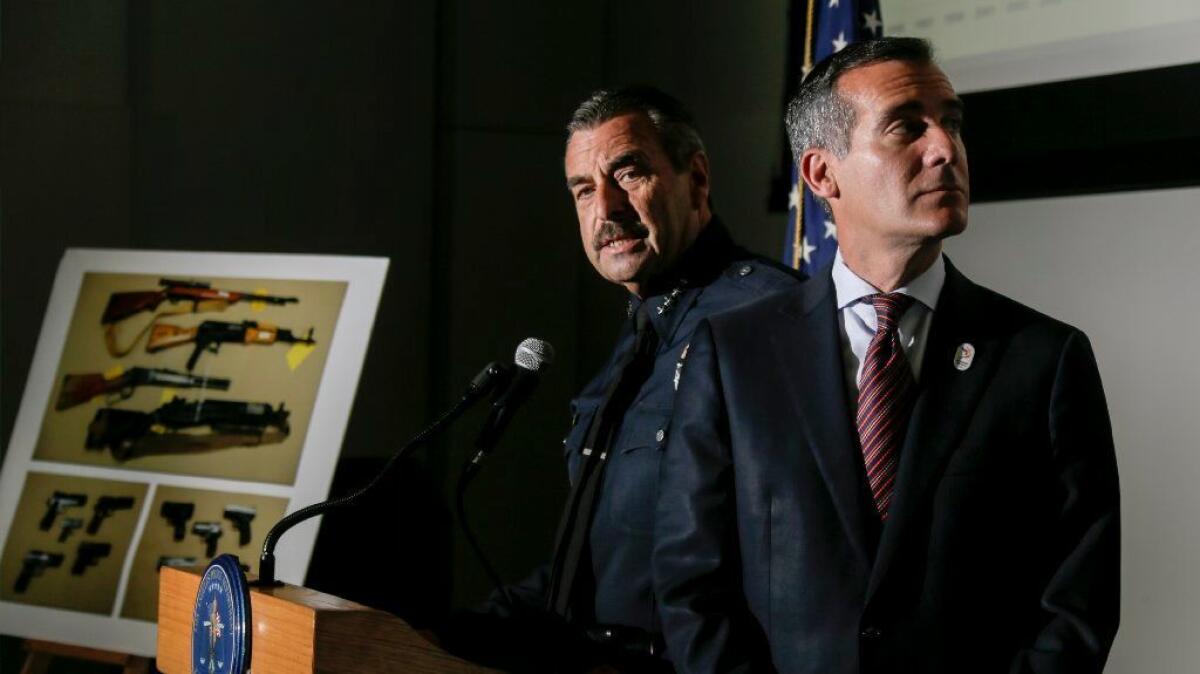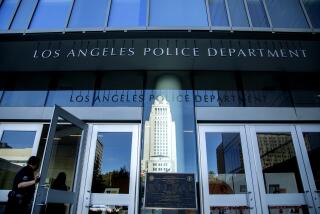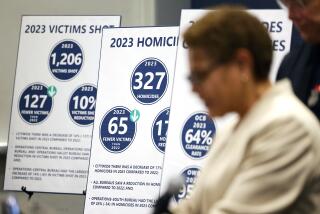L.A. residents’ frustration with rising crime is a challenge for Garcetti’s reelection bid

- Share via
When thieves broke into Dennis DiBiase’s Woodland Hills home two days before Christmas, they swiped $30,000 in jewelry, including a diamond ring DiBiase planned to give his wife for the holiday. They even hauled off a Sparkletts water bottle filled with three decades’ worth of coins.
The midday intrusion was the latest jolt to this San Fernando Valley neighborhood. Property crime has risen 24% since 2014 in the Los Angeles Police Department division that oversees Woodland Hills, an uptick that has residents calling for more police patrols.
Citywide, violent crime was up in 2016 for the third consecutive year. Property crime jumped for the second year in a row, with a double-digit increase for car-related thefts.
Reversing that trend has proved elusive for Mayor Eric Garcetti, who is seeking reelection. When he took office, the mayor vowed to use analytics and data to help improve city services — and by some measures, such as making streets cleaner, he’s been successful.
But the city’s efforts to reduce crime are complicated by rising homelessness, gang activity and the effects of Proposition 47, which downgraded some crimes to misdemeanors.
Garcetti is the first Los Angeles mayor faced with rising crime in more than a decade. After 12 years of declines, violent crime climbed for the first time in 2014 — Garcetti’s first full year in office.
The next year, both violent and property crime increased. Those numbers crept higher in 2016.
Residents say more crime — along with increasing homelessness — has changed their neighborhoods. And some are frustrated by what they believe is a lack of urgency, and leadership, at City Hall.
Brent Page, head of the Southwest Area Neighborhood Development Council, regularly sees police cruisers in his South L.A. neighborhood, but he said response times are an issue. Residents tell him that officers react quickly to a call only if there’s a shooting or a weapon is involved.
“I want to know what Garcetti’s plan is for the LAPD and crime,” Page said. “It’s something that we need to look at during budget time.”
Despite the uptick, Los Angeles remains far safer than in the 1980s and 1990s, when gang wars and a crack epidemic roiled neighborhoods. Nearly 1,100 people were killed in 1992 in the city, compared with 294 last year.
“Politicians take credit when the crime goes down, so naturally they’re going to take some heat when crime is up,” said Raphael Sonenshein, executive director of the Pat Brown Institute for Public Affairs at Cal State L.A. “But it’s worth keeping in mind how high crime was 20 years ago.”
It’s the only thing he should be doing: police and fire, No. 1 and No. 2.
— David Lasher, Porter Ranch resident
For big-city mayors, bringing down crime is a major resume-booster.
Garcetti’s predecessor, Antonio Villaraigosa, expanded the LAPD and ended his two terms with a decrease in crime. He now touts his work making L.A. safer as he campaigns for governor.
Drawing criticism, Garcetti broke tradition in January by not holding an annual news event to talk about 2016 crime numbers. His office cited a scheduling conflict and stated that crime statistics are available on the LAPD’s website.
Mayoral candidate Mitchell Schwartz held a news conference last month to accuse Garcetti of ducking the issue during the election season.
Garcetti said in an interview this year that the city acted aggressively to address the crime increase, which he believed had stabilized. The mayor said data show crime “flattening” in latter 2016 and early 2017.
“We are at a place where this year we can expect it to be flat or coming back down,” Garcetti said. “And given how historically low it is and how much different this town is than before, I think that’s a pretty significant accomplishment.”
Although crime rose again in 2016, LAPD statistics show the pace of the increase slowed in the second half of the year. Midyear, violent crime was up 16.3%, and it finished the year with a 10.2% increase.
Overall, crime went from a 6.6% increase in June to a 5.5% increase at the end of the year.
People don’t want things to go back to the way they were.
— Jorja Leap, UCLA professor
Statistics through Feb. 18 show that overall crime is up 1.2% in 2017 compared with the same period last year. LAPD officials caution that the numbers can fluctuate early in the year.
When asked about the most recent crime figures, Garcetti said Thursday that he was “encouraged by the positive trend so far this year, but we have more work to do.”
The mayor’s low-profile response to this year’s crime statistics contrasts with how visible he was following a surge in 2015. “This is bad news,” Garcetti said at a news conference that year to detail crime stats. “Let me be clear: Any uptick in crime is unacceptable.”
The 2015 expansion of the LAPD’s Metropolitan Division — a strategy unveiled by Garcetti in his State of the City address — allowed the department to send more officers to neighborhoods hit hardest by violent crime.
Jeff Gorell, Garcetti’s deputy for public safety, said the mayor intends to add more officers to housing units in South L.A. this year and will continue work on crime-fighting programs that he said had proved successful in the past.
DiBiase, whose home was burglarized, said residents in his neighborhood need to install security systems amid what he believes is a lack of police presence in the area.
“We need more officers,” he said.
LAPD data show that crime rose last year in some parts of the city that are traditionally considered safer, such as West L.A., where robberies jumped by 17% and motor vehicle thefts by 27%. In the Topanga Division, which encompasses Woodland Hills, violent crime rose almost 20%.
Porter Ranch resident David Lasher said he plans to vote for Schwartz. He wants more attention paid to public safety, adding that he had to wait 45 minutes for police to arrive after his home was burglarized in 2015.
He criticized Garcetti for focusing on issues related to immigrants in the country without legal permission.
“It’s the only thing he should be doing: police and fire, No. 1 and No. 2,” Lasher said. “I don’t care about the street-vending stuff. If you can’t live in your home in happiness, in peace, you have nothing.”
After persistent complaints from his Westside constituents about a lack of police patrols, City Councilman Mike Bonin unveiled a plan in January to get more officers on the streets by shifting officers to neighborhoods from desk jobs and other nonpatrol assignments.
His proposal mirrors one by the Los Angeles Police Protective League, the union that represents rank-and-file LAPD officers. In a recent survey of union members, 87% said their stations did not have enough officers to respond to 911 calls in a timely manner.
The police union, which endorsed Garcetti, wants to hire civilians for jobs now assigned to sworn officers. They also want to address what they describe as a flawed workers compensation system that keeps officers out of work for too long.
Dustin DeRollo, a union spokesman, said there’s been progress in dealing with crime under Garcetti, but more needs to be done.
“The crime problem in Los Angeles and the staffing problems that we have, they’re not simple to fix,” DeRollo said.
UCLA professor Jorja Leap, who helps run a leadership program in Watts, believes finding employment and deportation fears are more of an issue for South L.A. residents than crime.
But there’s concern among locals about the uptick, she said, and residents want to continue working with the LAPD on community initiatives.
“People don’t want things to go back to the way they were,” Leap said.
Times staff writers Michael Finnegan and Ben Poston contributed to this report.
Twitter: @dakotacdsmith
Twitter: @katemather
ALSO
Cash, weapons and armor seized in pre-dawn raid targeting drug trafficking ring
Thousands expected to attend memorial service for Keith Boyer, slain Whittier police officer
Baca ‘was aware’ of plan to obstruct FBI, former sheriff’s official tells jury
More to Read
Sign up for Essential California
The most important California stories and recommendations in your inbox every morning.
You may occasionally receive promotional content from the Los Angeles Times.












